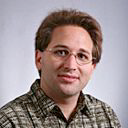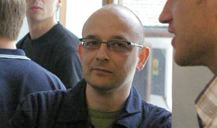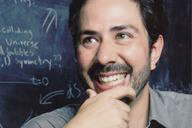"Analog or digital?" seems like an old-fashioned question, perhaps last posed in a stereo-equipment store circa 1992. But when it comes to the Universe, "analog or digital?" may be the most cutting-edge question in cosmology today.

Paul Davies
Paul Davies, a physicist and Director of the Beyond Center for Fundamental Concepts in Science at Arizona State University, considered this question when starting to write a book a few years ago. At the time, Davies thought he already knew the answer: Analog. "I had an image of the world of physics in terms of infinitely precise mathematical relationships existing in some sort of transcendent Platonic realm," recalls Davies, adding that most physicists still view the world in this way.
Indeed, much of the mathematics that underpins physics, particularly calculus, conjures up an analog, or smoothly varying, vision of the Universe. For instance, the differential equations important to calculations of Newton's laws can be thought of as analog-style "computers", because the resulting answers appear on a continuous spectrum. "The division of intervals [on this spectrum] can be made infinitely precise," Davies points out.
But Davies soon changed his mind. While mulling material for his book, The Cosmic Jackpot, Davies spent some time thinking about the holographic principle, a conjecture deriving from 1970s work on black holes by Jacob Bekenstein and Stephen Hawking — and which, sadly, has nothing to do with the hologram deck where Data played poker against Hawking in Star Trek Next Generation.
Bekenstein and Hawking discovered that all information contained within a black hole may be completely represented on the hole's surface. In other words, a black hole's information content is proportional to the hole's (smaller) surface area, not its (larger) volume. Physicists later extended the holographic principle beyond black holes to any volume of space, implying that the information density of the Universe is significantly less than previously believed.
That did it for Davies. "[The] total information processing capacity of the Universe is not only a finite thing — there is also a finite quantity of information that can be accommodated within the observable Universe," Davies says. And a limit on the ultimate allotment of information should impose a limit on the ability of physical laws to make infinitely precise predictions, he reasons. So every equation, every experiment, every piece of matter in the Universe must have a fundamental limit beyond which we — or any information-gathering system for that matter — could even in principle discern any finer detail. That is, the Universe is digital.
"Taken at face value, if the Universe is a finite state machine," asserts Davies, "then whatever future it has will get repeated again and again and again." If Davies is right, the past should repast itself as well — perhaps giving hope to the wax lovers haunting that 1992 stereo-equipment store.
Ape or human?
As Davies admits, not all physicists share his view. For Scott Aaronson, assistant professor of electrical engineering and computer science at MIT [at the time of writing], the answer to the question "Analog or digital?" might be: Depends.

Scott Aaronson
"Our basic framework for almost all of physics is continuous at one level (that of the wavefunction) but discrete at another (that of observable quantities like the light particles in the slit experiment)," he says. According to Aaronson, this apparent duality is not a paradox but an "artefact of trying to force a precise mathematical theory into vague, pre-mathematical categories."
To illustrate, Aaronson refers to the famous and deceptively simple double slit experiment, in which a strong light is shone upon two razor slits in front of a screen. When one of the slits is blocked, the light appears as a single bright line on the screen. But when both slits are open, a surprisingly intricate pattern develops. The reason? Light is both a particle and a wave: The single slit allows light's "particle side" to shine, so to speak, while the double slit highlights light's "wave nature."
"If you measure which slit a photon goes through," Aaronson says, "you get a discrete answer; but if you don't measure, then it can be in any continuous linear combination of going through one slit and going through the other one. Quantum mechanics tells us that the Universe can be discrete at the level of measurement outcomes, yet continuous at the level of the wave function from which the measurement outcomes are computed."
Aaronson offers another analogy. "Suppose you're a biologist and you're asked whether Australopithecus was really an ape or really a human? Should you say it was both or neither?" Aaronson says the question isn't fair: which characteristics define apes, which define humans, and how so? If the categories don't fit, then Aaronson thinks that maybe the question itself should change.
One lump or two?
Caslav Brukner, a professor of physics at the University of Vienna, answers the question "analog or digital?" by drawing a third analogy, with the world of real numbers.

Caslav Brukner
Real numbers are comprised of rational numbers those that can be represented as a fraction of two integers and thus having a finite or periodic decimal expansion, and irrational numbers those that can't. For example, the number  is rational, because it may be completely represented as a decimal by
is rational, because it may be completely represented as a decimal by  ; in contrast,
; in contrast,  is irrational, for its value can only be approximately specified as
is irrational, for its value can only be approximately specified as  The ellipsis indicates that the number
The ellipsis indicates that the number  continues forever without any periodicity: at last check, for over a trillion places more — and counting.
continues forever without any periodicity: at last check, for over a trillion places more — and counting.
According to Brukner, measurement results must be expressed in rational numbers. "Even when we make very precise measurements, we obtain rational answers," says Brukner, "because we can only use finite resources to perform our measurements and we can understand and communicate results of our observations using only finite amounts of information."
Yet, despite the impossibility of measuring irrational numbers, physicists long incorporated them into an imaginary "gap-less description of physical reality" — in classical mechanics at least. As an example, Brukner describes an experiment to determine the spin of a particle along an arbitrary direction in three- dimensional space. In classical physics, the particle has definite spin values along all possible directions independent of observation. But the discovery of quantum mechanics in the early twentieth century put an end to all that: it was found that it is impossible to infer at the same time the spin components along two different directions in space, say, the  and
and  direction.
direction.
As Brukner puts it: "In quantum theory, the set of all possible experimental questions that can be asked about a system is continuous, but the number of possible answers the system can provide is finite and discrete." What was once thought to be a smooth spectrum of all possible measurement outcomes — the hallmark of classical theory — pixelates, in quantum mechanics, into choppy sets of possible and impossible observations.

Anthony Aguirre
"How can a tiny microscopic quantum system 'know' the answers to an infinite (continuous) number of possible experimental questions?" asks Brukner rhetorically. It can't. Rather, Brukner says that conceptual problems arise when insisting on a description in which the particle has definite spin ("up" or "down") along every possible direction in the continuum of the real numbers prior to and independent of observation. It is natural to assume that the quantum system contains a finite amount of information, and that this is the reason why outcomes are definite only along a finite number of measurement directions.
In other words, perhaps an idealised vision of an uninterrupted set of real numbers” has no place in the "real" (quantum) world. "I would not be surprised if it turns out that relying our theories on numbers that have a clear operational meaning such as integers and fractions, rather than on idealised real numbers of pure mathematics," says Brukner, "ultimately helps us to understand the message of quantum theory."
Deal or no deal?
Double slits, apes, irrational numbers: the analogies just pile up. But to what end? Is the question "analog or digital?" just a parlour game, like Data's poker match with Hawking?
"Well, the history of thought in physics has shown us that confronting such questions, which may force us to look at issues from a very different perspective, can be extremely important in creating new theories," says Anthony Aguirre of the University of California at Santa Cruz. "If, fundamentally, the world is not of this character, it will be both difficult to get used to, and will require us to continue to open our minds if we want to really understand nature."
Or, as the denizens of that stereo shop might say, "Far out, man."
About this article
This article is part of our Stuff happens: The physics of events project, run in collaboration with FQXi. It first appeared on the FQXi Community website in 2008. Click here to see more articles and videos about the role of events in computer science.
